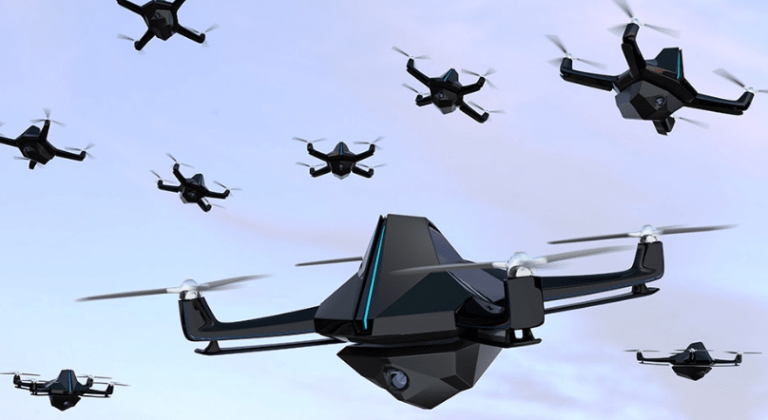From nuclear submarines to hypersonic weapons, AUKUS is now developing AI-powered drone swarms and target identification capabilities that may prove decisive in a Taiwan Strait conflict.
Breaking Defense reported that the UK Ministry of Defense (MOD) announced the first-of-its-kind AI and autonomy trial for aerial and ground vehicles occurred last month, with several claimed “world firsts” at the event showcasing AUKUS Pillar 2’s capabilities.
AUKUS’ advanced technology-sharing follows a two-pillar framework. Pillar 1 is a trilateral effort focused on supporting Australia to build a nuclear attack submarine (SSN) fleet.
In contrast, Pillar 2 focuses on accelerating cooperation in several high-tech fields such as cyber capabilities, artificial intelligence, quantum computing, hypersonics and counter-hypersonics.
Breaking Defense notes that the event was spearheaded by the UK’s Defense Science and Technology Laboratory (DSTL), which included “live retraining of models in flight and the interchange of AI models between AUKUS nations.”
The same report mentions that AUKUS teams developed AI models and directed each other’s air and ground systems tasked with target identification.
These assets, the Breaking Defense notes, include UK Blue Bear Ghost and Australian Insitu CT220 drones, UK Challenger 2 tanks, Warrior armored vehicles and Viking uncrewed ground vehicles, alongside an FV433 Abbot self-propelled gun and a BMP OT-90 infantry fighting vehicle.
Intelligent drone swarms may be a game-changing capability in a Taiwan scenario. Asia Times reported in May 2022 that drone swarms linked together by a distributed laser “mesh” data-sharing network were essential in securing a US victory in the Taiwan Strait during 2020 simulations conducted by the RAND think tank.
The drones used line-of-sight lasers to transmit data among each other, sharing targeting and flight data instantaneously between individual drones and effectively making the swarm autonomous.
Such intelligent drone swarms can work with manned stealth aircraft, extending the latter’s sensor range while maintaining electronic silence, thus drastically increasing the latter’s target acquisition capabilities.

They could also flood enemy radars with multiple targets, forcing the enemy to use limited air defense missiles and ammunition on expendable targets while manned stealth aircraft move in for the kill.
Machine learning and AI also enable drone swarms to look at targets from multiple angles, cross-check various targeting data streams and suggest the best attack.
For example, such capability may allow drone swarms to attack specific points on a warship, such as missile launchers, radars and engine compartments.
In line with the 2020 RAND simulation, Asia Times reported on February 2023 that the US is moving to accelerate the development of autonomous drone swarm technology that has already proved its worth in the Ukraine war and may prove decisive in a Taiwan contingency.
The US Department of Defense (DOD) has launched a low-profile program called “Autonomous Multi-Domain Adaptive Swarms-of-Swarms” (AMASS) to develop drone swarms that can be launched from sea, air and land.
AMASS aims to develop the capability to command autonomous drones working together to destroy enemy air defenses, artillery pieces, missile launchers and command centers.
Although details of the AMASS project are classified, pre-solicitation documents show that it is likely to focus on defeating or deterring a Chinese invasion of Taiwan.
Australia may already be deeply involved in US drone swarm projects. For example, Australia’s 2023 Defense Strategic Review mentions that collaboration with the US on the MQ-28A Ghost Bat should be a priority, with the drone capable of flying autonomously or with manned aircraft while being an expendable asset.
Drone-based target acquisition capabilities may also benefit AUKUS land-based precision fires in the Pacific. Asia Times reported in December 2022 that the US plans to build a “missile wall” in the Pacific, built around US Army and Marine Corps land-based missile launchers.
The US Army is testing its Typhon land-based missile launcher for its mid-range capability (MRC) program to provide long-range precision fires in the Pacific. It is designed to fire the Standard SM-6 or Tomahawk Block V missiles between 500 to 1,800 kilometers.
In the same direction, the US Marine Corps pursues a similar project with its Long-Range Fires program, using the same Tomahawk Block V missiles and other subsystems as the US Army’s Typhon.
Not to be left behind, Australia is also acquiring land-based missile launchers. The Strategist reported in April 2023 that the Australian Defense Force is seeking “land-based maritime strike” capability for a future conflict in coastal areas.

The Strategist report notes that a leading contender for this project is the Bushmaster troop carrier equipped with a pair of Naval Strike Missiles and advanced anti-ship weapons with a 250-kilometer range, the type of which are in service with the US Navy and US Marine Corps.
Such a level of advanced technology-sharing only happens in the tightest of alliances, with ingrained trust, shared culture and common language. The deep institutionalization of defense ties gives AUKUS an advantage over other Pacific security arrangements where those factors are lacking.
However, the high-tech AUKUS alliance may also have profound pitfalls. In a November 2022 Hudson Institute article, Koichiro Takagi notes that AI may outpace humans in decision-making speed, citing the risk of a flash war wherein opposing AI systems start an uncontrollable chain reaction that starts a conflict or even launches nuclear missiles.
He notes the tendency of humans to trust AI in the heat of battle, even if evidence shows that the AI’s decisions are incorrect. Takagi mentions that throughout history, it has not been superior technology and science that has won wars but the human intelligence that uses those tools.
He notes that future wars may not be determined by who has the better AI but by the innovativeness of the concepts that use it alongside human intelligence and creativity.

